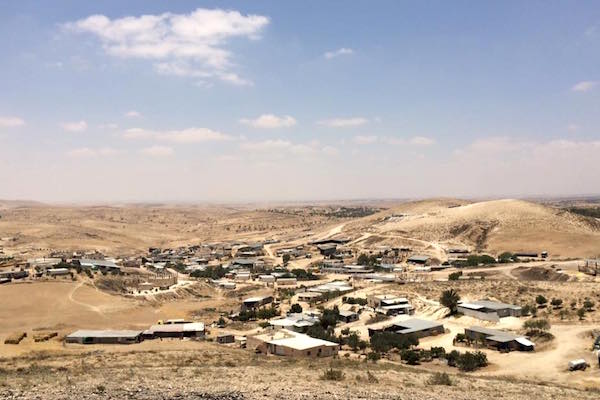If the Israeli government makes no distinction between Palestinians on either side of the Green Line, there is no reason for human rights activists to do so.
By Neve Gordon
Around 50 students sat on the concrete floor of a makeshift shack, absorbing the desert heat as they listened to Salim talk about the imminent destruction of Umm al Hiran and Atir, two unrecognized Bedouin villages located 20 minutes from my apartment in Be’er Sheva.
On May 6, the Supreme Court ruled that the villages could be destroyed, paving the way for the government to proceed with its plan to build a Jewish settlement called Hiran in place of Umm al Hiran, as well as to replace the adjacent village Atir with a Jewish National Fund forest. If these plans are actualized, approximately 900 Palestinian Bedouin citizens will be forcefully relocated from their homes.
Salim told the students what the village was planning to do in order to reverse the verdict, while insisting that the solution would not come from the courts. The courts, he said, operate in the service of power; “therefore we need to approach power directly; we need to convince Bibi [Prime Minister Netanyahu] to retract the demolition orders. We need to gather forces and protest against this immoral act,” he said.
At one point I turned to Salim and asked him why the residents of Umm al Hiran do not join forces with the nearby residents of Susya, who were also being threatened with eviction and demolition?
Just 20 kilometers separate Umm al Hiran from the small Palestinian village Susya. For over two decades Susya’s residents have been struggling against the efforts of Jewish settlers and the Civil Administration to dispossess them of their small swath of land. On May 5, one day before the ruling on Umm al Hiran and Atir, the Israeli Supreme Court decided not to issue an injunction against Susya’s demolition and the expulsion of its residents. There, too, the government can legally carry out its demolition plans at any moment.

Salim turned to me and answered: “They are in the West Bank and we are in Israel, they are living under occupation and we are citizens. We have rights as citizens. We are not the same.”
Somewhere along the 20 kilometers that separate the two villages lies the Green Line. If once the Green Line was conceived as a border that could provide a just solution between Israelis and Palestinians, it currently serves as a very effective mechanism of colonial control. It operates primarily as a separating device that has, since 1967, produced the fictive promise of two states. In reality, however, this Green Line helps sustain a racist regime. After all, it functions to obfuscate that the logic motivating the effort to uproot the residents of Umm al Hiran and the residents of Susya is one and the same: the Judaization of space.
Paradoxically, the Green line is not only utilized by the Israeli government to help sustain Israel’s colonial rule—it has also been appropriated by an array of other actors, including foreign diplomats, donors, human rights NGOs, and the Israeli public at large—both Jews and Palestinians.
Consider the field of human rights. Most donors and human rights organizations focus on one side of the Green Line; they either give funding to NGOs promoting the rights of Palestinians in the West Bank, or, alternatively, they provide financial aid to NGOs working in the pre-1967 borders, thus helping to reproduce the difference between the residents of Umm al-Hiran and Susya.
To be sure, Salim from Um al-Hiran is an Israeli citizen and Nasser al Nuajah from Susya is not. This difference, as any human rights lawyer will be quick to point out can, in certain instances, be meaningful vis-à-vis Israeli courts. Indeed, Salim’s answer to me is probably influenced by the human rights NGOs that have been helping his village to strategize in the face of imminent expulsion. And, yet, at this historical juncture, this distinction is being used to elide the fact that both Salim and Nasser are Palestinians whose land is being expropriated in order to advance Israel’s Judaization project.
While it is true that colonial regimes have always used modes of divide-and-conquer to control the inhabitants, what is novel in the case of Israel\Palestine is that progressive donors and liberal human rights NGOs are unwittingly reinforcing these distinctions and the logic that produces them.
Knesset Member Ayman Odeh, the head of the Joint List, is well aware of the divisive impact of such distinctions, and recently went to speak with the residents of Abu Ghosh, one of two Palestinian towns on the road from Tel Aviv to Jerusalem that were not destroyed during the 1948 war. He told the residents that for years they had been stigmatized for having collaborated with the pre-state Zionist military forces, and then added: “You are not collaborators, you are Palestinians.” Odeh understands that the only way to resist domination is by uniting the dominated and overcoming the strategic division it has created on the ground.
Human rights organizations and their donors need to make a similar conceptual shift. Their work should focus on creating alliances rather than reinforcing colonial distinctions. It is therefore time that they internalize that the Green Line is not a solution but a fiction—and a violently destructive one at that.
Neve Gordon is the co-author (with Nicola Perugini) of the newly released The Human Right to Dominate. This article first appeared in Al Araby Al Jadeed.


